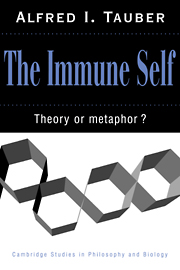Book contents
- Frontmatter
- Contents
- Acknowledgments
- Introduction
- 1 The phagocytosis theory
- 2 The triumph of immunology
- 3 The immune self declared
- 4 From theory to metaphor
- 5 Immunology gropes for its theory
- 6 The self and the phenomenological attitude
- 7 The self as organism: A philosophical consideration
- 8 The search for identity
- Notes
- References
- Index
4 - From theory to metaphor
Published online by Cambridge University Press: 14 January 2010
- Frontmatter
- Contents
- Acknowledgments
- Introduction
- 1 The phagocytosis theory
- 2 The triumph of immunology
- 3 The immune self declared
- 4 From theory to metaphor
- 5 Immunology gropes for its theory
- 6 The self and the phenomenological attitude
- 7 The self as organism: A philosophical consideration
- 8 The search for identity
- Notes
- References
- Index
Summary
THE IMMUNE SYSTEM
The preceding three chapters have traced the conceptual and scientific history of immunology. There has been limited reference to the broader cultural setting and underlying philosophical orientations in conflict during the discipline's development. In a sense, I have attempted to set the stage for the ensuing discussion, which seeks to explore the interface between the science and its governing philosophy. To do so, the self concept will be carefully delineated, both as theory and as metaphor. So, first, let us briefly review the prevailing theory of immunology a century after the humoral-cellular debate was at its peak. As already summarized, by 1908, when Metchnikoff and Ehrlich shared the Nobel Prize, the basic character of immune reactions were known. There are basically two forms of immune recognition: natural and acquired immunity. Natural immunity is characterized by effector cells and soluble factors that do not require specific or prolonged induction for their functions and more specifically do not require opsonization (coating) of their target. Such coating of the pathogen with antibody and other serum proteins offers “handles ” for attachment and engulfment by specialized “eating cells ” - phagocytes. The encounter with a phagocyte serves as the host's initial cellular defense action. This can result in the destruction of the microorganism by a blood or tissue phagocyte, and if the encounter is with an antigen-presenting cell (APC), a more complex interaction occurs, whereby the antigen (that constituent which elicits an immune response) is “processed,” initiating the immune recognition (i.e., lymphocyte network) process.
- Type
- Chapter
- Information
- The Immune SelfTheory or Metaphor?, pp. 124 - 155Publisher: Cambridge University PressPrint publication year: 1994



